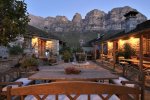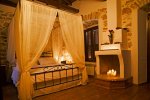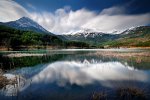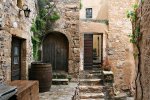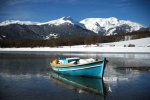The boat leaves verdant Peloponnese behind and sails to an equally verdant island. In the foreground, Bochali Hill towers over the city of Zakynthos, while the lush mountains of the mainland loom further back. As the boat approaches, they emerge like exotic landscapes, resembling those seen in Korean films, where green hills seem to rise straight out of the sea. It’s Zante, il fior di Levante (the flower of the East), as the Venetians called it, a lush island, surrounded by emerald waters and featuring many hidden beauties.
Zakynthos suffered total destruction in the earthquake of August 1953, when almost all the buildings on the island collapsed, with the exception of the Church of Agios Dionysios, the building which today houses the National Bank, and the school building in Ammos district, which were built to a high level of ductility. As a result, modern downtown Zakynthos is not the definition of picturesque anymore, but deep into the mainland the scenery changes thanks to the trees, the vineyards and the many beautiful cottages.
Zakynthos, like the rest of the Ionian Islands, spent many years under the Venetian rule. From 1492, the government of Venice relocated many of its citizens to the island, thus facilitating an era of renaissance and prosperity. For almost three centuries, the Venetian rule allowed culture and architecture to blossom, to the point where Zakynthos earned the title of the “Florence of Greece”.
On May 21st, 1864, and while Greece had already reclaimed its independency, the residents of Zakynthos, under the leadership of Konstantinos Lombardos, were united with the Greek state, and the Greek flag was hoisted on the island. Amongst the remains of the Venetian presence on the island is the influence on the dialect. Zakynthians use many idioms of Italian origin and a unique intonation when they speak which make the language sound more musical, especially when they speak quickly with each other. This ‘musical feature’ is characteristic of their dialect, as is their tendency to gesture when they speak.
Zakynthos has a varied landscape - large, sandy beaches in the Southern and South-Eastern parts of the island and steep cliffs and coves which are inaccessible by land in the Western and North-Western parts. There are fertile plains from the Gulf of Alikes to the Bay of Lagana and mountains, like Vrachionas to the West and Skopos till the Cape of Gerakas. The main town of Zakynthos is located in the lowlands of the South, where one will also find the vineyards which offer the tasty local wine and raisins of Zakynthos.
The mild Mediterranean climate along with the humidity and frequent rainfall during the winter has created the luscious green landscape that exists on the island.
The fauna is also very diverse, with many species of migrating birds visiting the island, but also the Mediterranean Monk Seals (Monachus Monachus) which enjoy the crystal clear waters of the rocky Western part of the island. Amongst the visitors of the island are the sea turtles Caretta Caretta (a pre-historic species which has survived until our time) that come to the sandy beaches every summer in order to lay their eggs.
The springtime, before the sun beds are taken out onto the beaches, is the best time to visit the island in order to enjoy its natural beauty.
Use the map or the alphabet below to find your favorite destination!
Achaea Prefecture
Aegina
Aetoloakarnania Prefecture
Agathonisi
Agistri
Alonissos
Amorgos
Anafi
Andros
Antiparos
Arcadia Prefecture
Argolida Prefecture
Arta Prefecture
Astypalea
Attiki Prefecture
Kalymnos
Karditsa Prefecture
Karpathos
Kasos
Kastelorizo
Kastoria Prefecture
Kavala Prefecture
Kea (Tzia)
Kefalonia
Kerkyra (Corfu)
Kilkis Prefecture
Kimolos
Korinthia Prefecture
Kos
Koufonisi (Ano & Kato)
Kozani Prefecture
Kythira - Antikythira
Kythnos
Samos
Samothrace
Santorini
Schinoussa
Serifos
Serres Prefecture
Sifnos
Sikinos
Skiathos
Skopelos
Skyros
Spetses
Symi
Syros
Would you like to combine skiing in the morning and then go swimming in the afternoon, all in one region? Click to choose your interests and see in which part of Greece you enjoy them. Combinations are endless!
